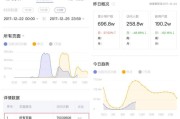微信+ECharts小程序实现了一组参考函数的动态刷新
小程序中实时(间隔1秒等)获取的数据可以是网络数据也可以是小程序中函数生成的数据,并且数据更新频率必须同步显示。条形图仅在单击按钮时出现,直到单击按钮后才会出现。
显示效果:X轴是数据T,是一个计数。 Y轴上有两条数据(dataPV、dataSP)与X轴同步变化(这里的多个数据其实可以包装成一个大数组,但我还没学会怎么做)。 ![]()
1。从ECharts官网下载echarts。您可以完整下载它或对其进行自定义。我需要折线图,所以我选择自定义下载。
下载站点:ECharts网建(apache.org),下载时选择需要的图表,不要选择工具集(工具集有将图表保存为图片等功能)。
2。将ec-canvas复制到小程序目录下,并将下载的js文件替换为固定值。
3 在 .json 中定义:
{
"usingComponents": {
"ec-canvas": "../../ec-canvas/ec-canvas"
}
}4 在 .wxml 中插入图表:
<view class="my-chart">
<ec-canvas id="lazy-mychart-dom" canvas-id="lazy-mychart" ec="{{lazyEc}}"></ec-canvas>
</view>5 在 .wxss 中定义样式:
.my-chart {
width: 750rpx;
height: 500rpx;
}
ec-canvas {
width: 100%;
height: 100%;
}5 在 .js 中引入图表:
import * as echarts from '../../ec-canvas/echarts'以上内容已在许多其他内容中详细介绍有不懂的地方可以参考一下。
3。在 .wxml 中添加一个按钮,然后单击该按钮以显示图表:
<button bindtap="changeType">折线图</button>4。全部.js代码如下(尽量标注清楚)
import * as echarts from '../../ec-canvas/echarts'
Page({
data: {
times: 0,
lazyEc: {
lazyLoad: true
},
dataT: [],
dataPV: [],
dataSP: []
},
onLoad(options) {
//获取到组件
let that = this;
this.lazyComponent = this.selectComponent('#lazy-mychart-dom')
setTimeout(() => {
this.init([])
}, 1000)
},
init(optionData) { //手动初始化
this.lazyComponent.init((canvas, width, height, dpr) => {
let chart = echarts.init(canvas, null, {
width: width,
height: height,
devicePixelRation: dpr
})
let option = getOption(optionData) // echarts的配置信息
chart.setOption(option)
this.chart = chart //将图表实例绑定到this上,方便其他函数访问
return chart
})
},
//mark:点击支出收入
changeType(e) { //确定按钮,只按一次,可以根据需要做逻辑disable掉
var temprrT = new Array(50).fill(0);//50个数组,根据需要修改
var temprrPV = new Array(50).fill(0);
var temprrSP = new Array(50).fill(0);
var times = 0;
this.data.dataT = this.data.dataPV = this.data.dataSP = [0];//这句好像没什么用
var i = setInterval(() => {
times++;
if (times >= 50) { //同上,数据个数根据需要修改
clearInterval(i)
} else {
temprrT.shift()
temprrT.push(times)
temprrPV.shift()
temprrPV.push(Math.random().toFixed(2))
temprrSP.shift()
temprrSP.push(Math.random().toFixed(2))
console.log('数组', temprrT, temprrPV, temprrSP)
this.setData({
dataT: temprrT,
dataPV: temprrPV,
dataSP: temprrSP
})
}
let option = getOption(this.data.dataT, this.data.dataPV, this.data.dataSP)
this.chart.setOption(option)
}, 1000);
},
})
//mark:getOption
function getOption(dataT, dataPV, dataSP) {
return {
title: {
text: '趋势图',
left: 'center'
},
color: ["#37A2DA"],
grid: {
containLabel: true
},
tooltip: {
trigger: 'axis',
},
xAxis: {
type: 'category',
boundaryGap: false,
data: dataT
},
yAxis: {
type: 'value',
scale: true,//自动Y轴坐标居中
boundaryGap: ["0.1", "0.1"],//上下留白10%
splitLine: {
lineStyle: {
type: 'dashed'
}
}
},
series: [
{
name: 'PV',
type: 'line',
showSymbol: false,
smooth: true,
color: ["#00cc00"],
data: dataPV
},
{
name: 'SP',
type: 'line',
showSymbol: false,
smooth: true,
color: ["#f08080"],
data: dataSP
}
]
}
}版权声明
本文仅代表作者观点,不代表Code前端网立场。
本文系作者Code前端网发表,如需转载,请注明页面地址。
 code前端网
code前端网




发表评论:
◎欢迎参与讨论,请在这里发表您的看法、交流您的观点。